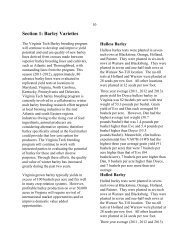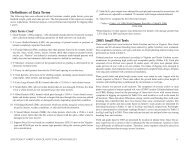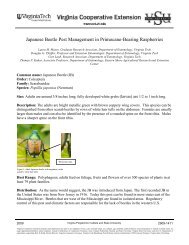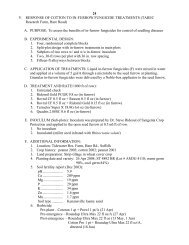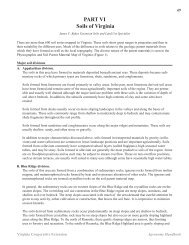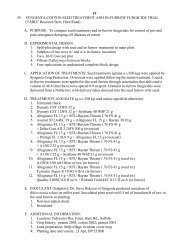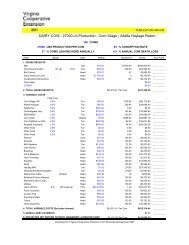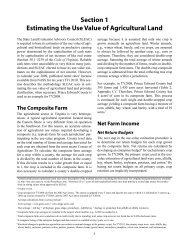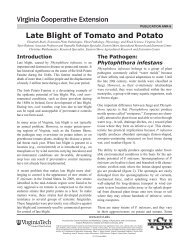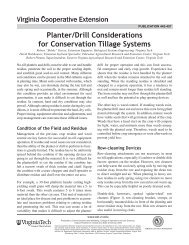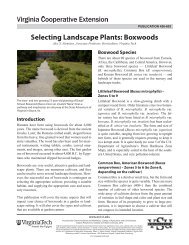PDF (1 MB) - Virginia Cooperative Extension - Virginia Tech
PDF (1 MB) - Virginia Cooperative Extension - Virginia Tech
PDF (1 MB) - Virginia Cooperative Extension - Virginia Tech
Create successful ePaper yourself
Turn your PDF publications into a flip-book with our unique Google optimized e-Paper software.
TABLE 11<br />
Calendar of Jobs for Carry-Over Strawberries on Plastic Mulch<br />
1. July 1 - After harvest, by 7/01, broadcast spray 2,4-D amine, labeled formulation, 1.5 Qts/A.<br />
NOTE: If plant-killing diseases are present, destroy planting, do not carry-over.<br />
2. July 14 - 2 weeks after spraying 2,4-D mow berry plants 2” above plastic mulch.<br />
3. July 14 - After mowing off as above, if you have more than 5 branch crowns on average,<br />
set shielded sprayer so shields expose outer 1/2 of plants on each row on the beds, set<br />
shield height to just clear the crowns, spray with 2 pints/acre of Gramaxone and crop oil<br />
to thin crowns for better fruit size next year.<br />
4. July 15 - Drip irrigate to wet beds shoulder to shoulder (7 hours of drip @ 12” in-line<br />
emitters, beds on 5’ centers = 1 acre inch to beds). No fertilizers in summer months.<br />
Goal: keep plants alive, but not fast-growing (controlled moisture stress).<br />
5. August 15 - Drip irr. beds as above. Goal: same as above.<br />
6. September 1 - Take plant tissue analysis or soil test the carry-over beds. Typically in this<br />
area, beds will test high in nitrogen, medium or medium-low in both phosphate and potash.<br />
7. September 15 - Drip irrigate to wet beds shoulder to shoulder, but this time at 2/3 of the<br />
way through the drip cycle, fertigate nutrients as per tests needs, typically may need to<br />
add 15-20 #/A of phosphate and potash, smaller amounts of nitrogen. One option is to<br />
fertigate with solubles such as 12-48-8 or 9-45-15 followed by 8-15-36. Mixing them can<br />
cause salting out or heavy fertigator-clogging precipitates, use in sequence. Other options<br />
are liquids such as 11-48-0 followed by 0-0-30. Note: see examples at end for calculating<br />
how much/acre to fertigate.<br />
8. September 20 - Spray row middles with Gramoxone, shielded sprayer as per VCE<br />
Pub. 456-420, for all vegetation including rooted berry runners filling row middles. If<br />
foxtail or other tall grasses have filled middles, use Poast, crop oil plus ammonium<br />
sulfate activator as per Poast label prior to use of Gramoxone in middles. Remove crop<br />
shields for Poast spray to cover grass over beds and raise spray boom to high position to<br />
completely spray overtop of grass in middles.<br />
9. October 1 and 15 - Last drip irrigations of the season, wet beds shoulder to shoulder. If you<br />
didn’t pre-plant fumigate to kill soil insects in beds, field mice and voles may move into beds<br />
to feed on grubs and bugs or just to overwinter, even in fields that were fumigated, destroying<br />
drip tape and plants. Adults of the May Beetle family lay their eggs on sod. Their grub larvae<br />
devour strawberry roots, one of their favorite food host plants. They have nearly ruined some<br />
fields, so best to use a soil insecticide labeled for strawberries (VCE Pub. 456-420) or plan<br />
to bait beds with mouse poison placed under the plastic mulch. Injury has been most severe<br />
where strawberries rotate behind sod with no fumigation or soil insecticides.<br />
10. October 16 - Winterize and drain all drip components, filters, lines. Order winter/spring crop<br />
covers or obtain a frost control sprinkler system. Don’t bet on another ‘Carolina winter.’<br />
20



